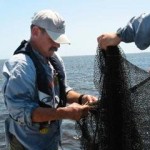University Researcher Calls New Database the “Who Eats Who” of the Gulf of Mexico
Editor’s Note: Today’s feature is courtesy of Texas A&M University-Corpus Christi.
from The Fishing Wire
CORPUS CHRISTI, TEXAS- About 1,500 marine fishes make the Gulf of Mexico their home. From birds, to fish, and marine mammals to crustaceans, the Gulf of Mexico Species Interaction database (gomexsi.tamucc.edu, created by a researcher at Texas A&M University-Corpus Christi, currently has diet data on over 600 of the marine fishes. It is the first and only database of its kind for the Gulf of Mexico that shows how the cataloged animals interact with each other in the food web.
“Unless you’re a scientist or grad student, you may have never wondered what preys on porcelain crabs,” said Dr. James Simons with the University’s Center for Coastal Studies. “But if you’re a fisherman, you would probably like to know what type of critters your favorite game fish likes to eat.”
Simons started collecting data on how the different species of the Gulf interact in 1987, but it wasn’t until 2002 that he got the idea to put all of the information he had collected into one, easily-accessible place: the worldwide web.
“In any ecosystem, it is important to know the food web, or who eats who,” said Simons. “This food web is the biostructure that shows us the pathways by which energy flows through the ecosystem.”
The scope of data in GoMexSI (gomexsi.tamucc.edu) includes the estuaries and coastal waters of Cuba, Mexico, and the United States and all of the Gulf waters to the deepest realms. Simons says the database has already proven valuable to various research projects including the National Oceanic and Atmospheric Administration’s Integrated Ecosystem Assessment program that is using the data for diet information on fish that will aid in the construction of fishery ecosystem models. The effort has also enabled the detection of data gaps that will help to direct future data gathering efforts.
Recently the data were used for a Gulf of Mexico Alliance project that seeks to understand the movement of mercury through Gulf food webs. The data that Simons has collected was used to construct food webs for the king mackerel in six locations around the Gulf.
Dr. James Simons “if you’re a fisherman, you would probably like to know what type of critters your favorite game fish likes to eat.” Photo from Texas A&M – Corpus Christi.
“Fisheries are especially important in the Gulf as a source of employment, income, recreation, and food,” said Simons. “The detailed data provided by this project will hopefully improve the accuracy of the fishery models that are used, in part, to make management decisions.”
Simons also hopes to work with the Texas State Aquarium to develop a GoMexSI app that would show people, at any given display, where the fish they are seeing fit in the food web.
“For example, at the Aquarium, you may see ten fish in a tank, but the fish that eat those fish are not in the same tank, for obvious reasons, so you are only seeing half of the ecosystem,” said Simons. “Seeing the other half of the picture would be invaluable to young students.”
The GoMexSI project already has over 45,000 digital records of species interactions, and Simons hopes that is just the beginning. The data comes from a wide variety of sources including abstracts, contributed datasets, proceedings, unpublished manuscripts, peer-reviewed literature, theses, and government reports. Simons and his team are currently extracting and standardizing the data to make it easier to explore and use.
“The most commonly used data are the data that are easy to find,” said Simons. “So, for example, while information from an unpublished manuscript or a thesis may have the best data for a given species, it isn’t used because it’s nearly impossible to locate.”
About Texas A&M University-Corpus Christi: Offering more than 60 of the most popular degree programs in the state, Texas A&M-Corpus Christi has proudly provided a solid academic reputation, renowned faculty, and highly-rated degree programs since 1947. The Island University has earned its spot as a premier doctoral-granting institution, supporting two institutes and 13 research centers and labs. Discover your island at http://www.tamucc.edu/.
